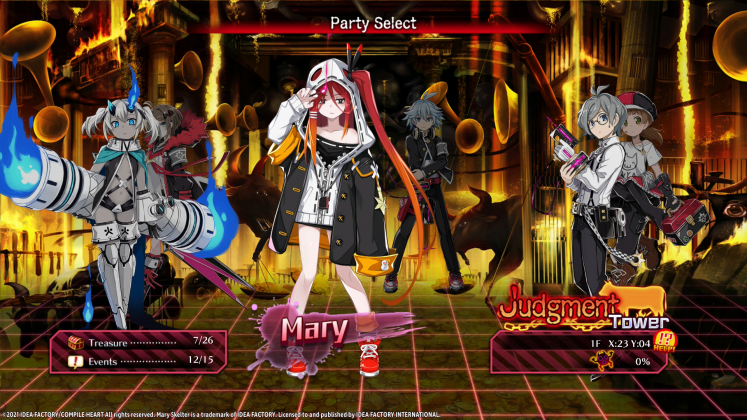Worth the patience

Video Game Review
The Caligula Effect 2
Nintendo Switch
Grand Theft Auto: The Trilogy – The Definitive Edition
Personal Computer via Steam
Mary Skelter Finale
Nintendo Switch
WHEN The Caligula Effect was released in 2016, it boasted of novel concepts, a not insignificant feat given the saturation in the industry. Centered around the idea of manipulating your actions during set intervals during combat, Caligula Effect was a game about push and pull. Each action you take would play alongside that of your opponent’s, and to really make the most out of your movements, you had to plan and compensate for how fast or slow they were, and how agile your opponent could be. This meant playing to your strengths as well as to your opponent’s weaknesses, opening up a surprisingly complex game of cat and mouse. You had legitimate options, like making the timing of your movements to just be slightly faster than your enemies’ so that your actions would counteract theirs. You could prepare moves that propelled you out of the range of their attacks, or launch deadly combos head-on and rely on having enough leeway to be able to dodge or run from their swings. You could even hope to interrupt the channel of their attacks and make them waste time trying to recover. It was a unique, if odd, system, but one that rewarded your patience and effort if you took the time to learn its nuances.
The Caligula Effect 2 demands much of the same patience to really get the most out of it, as it keeps similar battle systems, writing themes, and plot points to the original. However, where the original had faltered, Caligula Effect 2 seeks to pick up the slack, doubling down on its charm to keep you interested, all while slowly getting you to master its singular intricacies.
In The Caligula Effect 2, you start off in the world of Redo, run by the mysterious figure known only as Regret. During one of your school days, a crack in the sky opens up and exposes Redo as a fake virtual world. Meeting up with “X”, a supposed daughter of the antagonist in The Caligula Effect, you make up your mind to escape Redo and form the Go-Home Club, a ragtag bunch of other similar-minded students hell-bent on returning to the real world.
It’s a novel scenario, and The Caligula Effect 2 manages to leverage it well. The high school motif isn’t just for show, but also serves as a nice backdrop of you slowly learning the ropes of the unfamiliar environs you find yourself in. This is mostly done through exploration and combat. And, yes, it has all the staples of a good Japanese role-playing game, with dungeons to explore, quests to take on, characters to level up, and enemies to beat down and overcome.
At first glance, The Caligula Effect 2 might seem like standard fare, but two things really stop it from feeling like just any other cookie-cutter title. The setting of the world is its biggest plus, giving it a lot of leeway in how it is able to present itself. The supporting characters you meet are more complex than they seem, and have far more emotional baggage than their appearances imply. After all, in a virtual world, these same appearances can be deceiving, and the backstories they have make for some grim but interesting stories, often revealing details of troubled pasts and long-term trauma. It’s a bit on the nose with some of its reveals, particularly when they come from characters living in an idyllic world based around the escape of “Regret,” but for the most part, they are handled well, and give the story a surprising amount of weight behind it.
However, the plot is only half of a JRPG. Combat is another important part, and it’s one that The Caligula Effect 2 does pretty well. While it uses the timing-based combat frame of the first game, the system is now far more satisfying to engage in. Enemies can be juggled and interrupted during their attacks. The counters do wonders in allowing you to break an opponent’s guard or exploit their weaknesses, encouraging you to go all out in every battle you face. And while attacks do force you to commit, the ability of party members to cover for another’s frailties makes for a surprising amount of depth. It’s honestly a lot of fun, and with the game constantly encouraging you to push your limits, it’s an easy system to get used to, even if it’s conceptually hard to wrap your mind around sometimes.
As it is, the biggest issue The Caligula Effect 2 can run into is mostly in its optimization. Content-wise, Caligula Effect 2 has you covered with its interesting story, engaging combat, and nice atmosphere; however, it seems to be weighed down by technical issues, particularly when the Switch is undocked. Some slowdown during flashy combos do take a bit of wind off the game’s sails, particularly when it’s all about you needing to push your limits.
That said, The Caligula Effect 2 is all that it advertises itself as, and more. It’s a weird, interesting, but enjoyable JRPG, and it’s one that isn’t afraid to go into darker, more sensitive topics while still being respectful of all sides. It might not be a genre-defining game, but it’s still extremely enjoyable, and those who had a soft spot for the first game, or want a new JRPG to pour their love into, will certainly find lots to enjoy in Nippon Ichi Software and Historia Inc.’s home run.
THE GOOD:
o Enjoyable battle system that encourages experimentation and pushes you to your limits
o Grim but solid backstory, with good emotional payoffs for delving into them
o Engrossing theme and setting
THE BAD:
o Minor technical concerns
o Suffers from JRPG repetitiveness, particularly given the need for you to launch combos
o Mediocre padding in regard to extra content like side quests
RATING: 9/10
POSTSCRIPT: Few game series can lay claim to the gravitas that Rockstar Games’ Grand Theft Auto series carries. Like it or hate it, Grand Theft Auto is iconic in what it does, and brings to the table its intense stories about living the life of a criminal hand in hand with its robust, enjoyable open-world setting. With a free sandbox to explore, many side activities to enjoy, and plenty of characters to love, it’s no wonder that so many have such an affection for the franchise. With the Grand Theft Auto releases being solid hits all around, and with plenty of remasters already lining the industry landscape, it really was only a matter of time before Rockstar Games did the same and remastered their older titles.
Grand Theft Auto: The Trilogy – The Definitive Edition is exactly that, overhauling Grand Theft Auto III, Grand Theft Auto: Vice City, and Grand Theft Auto: San Andreas with high-resolution textures, smoother frame rates, and a few new extra goodies that would have any big fan of the franchise salivating. After all, what better way to experience, or reexperience, Grand Theft Auto at its best?
To this extent, Grand Theft Auto: The Trilogy – The Definitive Edition delivers on getting its three games out. These three releases bring to the table their original content with some much-needed quality-of-life improvements to boot. The games themselves are mostly present in their original quality, and barring a few minor alterations such as a modernized control scheme, it’s the same games enjoyed via a modern system.
Unfortunately, Grand Theft Auto: The Trilogy – The Definitive Edition’s launch has been far from smooth, marred by technical issues and graphical bugs that diminish the experience greatly. The graphics for the most part have been upscaled. The resolution has been upped, and a distinct art style has been applied to make the lighting shine. Environmental effects like rain and lightning have been added, and when they work fine, they add to the charm of the game; an almost surreal feel will engulf you as you see bright neon lights reflect off concrete buildings.
However, the texture upscaling in Grand Theft Auto: The Trilogy – The Definitive Edition is far from perfect. Some character textures have been stretched even more across their models, accentuating the looks and designs that already seemed out of place in the original releases. The removal of the games’ fog effects hasn’t removed the texture pop-ins, and some areas look considerably worse when you can see vehicles and people spawn in. Worse, the rain effect at times just obscures the game screen, and can even follow you when you’re under buildings. These are all-new features with all-new bugs, and while the game is still playable, they do ruin the concept of a definitive edition if it feels undercooked.
There’s also the audio remaster in Grand Theft Auto: The Trilogy – The Definitive Edition. Characters sound muffled and distant, and while the original voices have been kept, the sound quality is far from what you’d expect of a company whose previous releases have all been of topnotch quality.
The technical missteps in Grand Theft Auto: The Trilogy – The Definitive Edition wind up hurting the gameplay. Issues like waypoint bugs, car sizes expanding when turning, and a fairly janky auto-aim system prevent it from feeling polished and ready. Instead, a lot of the time, it feels like both a step forward and a step back. Better-looking graphics, but more bugs to deal with. More QoL features, but more of the ways these same features interrupt the game flow. There’s a bizarre give and take that serves to highlight its wanting performance.
Which is just too bad, because Grand Theft Auto: The Trilogy – The Definitive Edition has a lot going for it. Rockstar Games pledges to keep working on it until it’s worthy of its legacy, not an empty promise given the publisher’s excellent track record. Until then, however, it’s a work in progress that is, at best, a sign of better things to come.
THE GOOD:
oStill-excellent storylines
oQuality-of-Life improvements
o Control updates suited for current-generation specifications
THE BAD:
o Imperfect texture upscaling
o Unbalanced audio remaster
o Technical missteps get in the way of gameplay
RATING: 6/10
THE LAST WORD: Mary Skelter Finale is an interesting experience. Its anime visuals belie a surprisingly engaging story that wraps up the series with its grit. Featuring a fairly robust customization system inside a dungeon-crawling RPG, Mary Skelter Finale is a type of game very rarely seen. At times, it can get overwhelming in its ambition, particularly with its long story segments. Underneath these flaws though, it’s still able to keep you immersed not just with its solid RPG gameplay, but also with its stories, characters, and the world you find yourself in.
And what a world it is. Mary Skelter Finale’s environs boast of fantasy and pure horror combined, featuring twisted monsters and cutesy characters in the same frame. It may feel disjointing and disjointed, but the seeming dichotomy plays perfectly into its dark fantasy. You’ll find yourself evading nightmarish ghouls that stalk you throughout colorful labyrinthine corridors. You’ll engage with the twisted denizens that lurk within the shadows, and you’ll even be playing to the whims of the dungeon. The supposedly disparate ingredients make for an experience that is, at times, hard to describe, but it tries its best to mitigate these hurdles, especially for newcomers.
For starters, Mary Skelter Finale has a “Before Story” prologue that tries to condense the plot points of the previous games into a digestible format. Numerous tutorials litter the game’s earlier stages as you play, and each of them explains the core mechanics you’ll be encountering to make sure you’re never unprepared. The interface is not perfect, especially as these concepts begin to blend in the later levels, but the attempt is no less daring in the deliberate intent to stray from the typical, and certainly a welcome change to veterans of the genre longing to go through novel experiences.
The mechanics aren’t that hard to understand, either. Things like switch puzzles and character progression are pretty standard fare for the genre, but the unique setups are where Mary Skelter Finale really stands out. The Nightmare chase for instance, adds a bit of tension to the exploration, forcing you to hurry your actions even as you’re being shadowed by an invincible boss monster. The dungeon also has a personality and set of desires, and fulfillment of the latter, usually by fighting in certain ways or exploring certain areas, gives big benefits and incentivizes risk-taking.
These are mostly minor things on the whole, but when mixed together, makes for a unique RPG experience that has a constant forward momentum. At very few points do you really feel like Mary Skelter Finale drags, and when it does, its humor and just the general feel are usually ample compensation.
That said, Mary Skelter Finale does have pacing issues that arise mostly from the story and the visual-novel-style conversations that come with it. The quality of these is a mixed bag; the writing tends to be very good on the whole, but the mere presence nonetheless kills pace and often serves as interruptions during gameplay. You’re taken away for minutes on end from your dungeon-crawling experience, not all that bad the first few times they occur, but subsequently winding up as tests of patience.
True, Mary Skelter Finale can be played and enjoyed without you going through most of the story segments. On the other hand, but it’s when the plot is threshed out that the game truly begins to shine — an unavoidable paradox. The atmosphere is already laid on thick with the world you explore and the characters you encounter. The story walks the narrow line between hope, humor, and horror. The areas you explore and the actions you perform always feel just a bit off and clashing. Which is why it’s tonally perfect for what it has on hand. The series has always pushed the boundaries of what you can expect, and Mary Skelter Finale is a culmination of all of its past ideas, combined into a solid game that has anime-style characters fighting off against three-dimensional abominations.
Mary Skelter Finale is weird, that much can be said, but it’s weird in a good — make that very, very good — way that underscores its uniqueness. If nothing else, it’s an outstanding title with an edgy personality, and if you can look past its cartoony visuals, you will find a strong dungeon crawler boiling beneath its surface. At the same time, you would do well to embrace the insanity that Mary Skelter Finale wants to push through skillful writing. Its pacing leaves much to be desired, but it’s worth the necessary tedium if you gladly invest your time and patience. Highly recommended.
THE GOOD:
o A sterling wrap-up to the series, embodying everything the previous games had in a bigger, better way
o Very solid dungeon-crawler gameplay, with lots of interesting mechanics to make it stand out
Solid writing and visuals, with strong messages underneath
THE BAD:
o A sterling wrap-up to the series, embodying everything the previous games had in a bigger, better way
o Pacing is a real issue in this type of genre, especially when some areas tend to go on and on
o Visual-Novel style cutscenes and conversations can be very off-putting
o Very easy to get lost in the story if you aren’t willing to go through the prologue
RATING: 9/10




